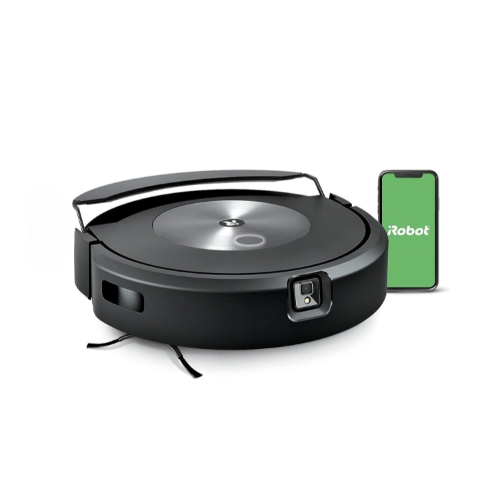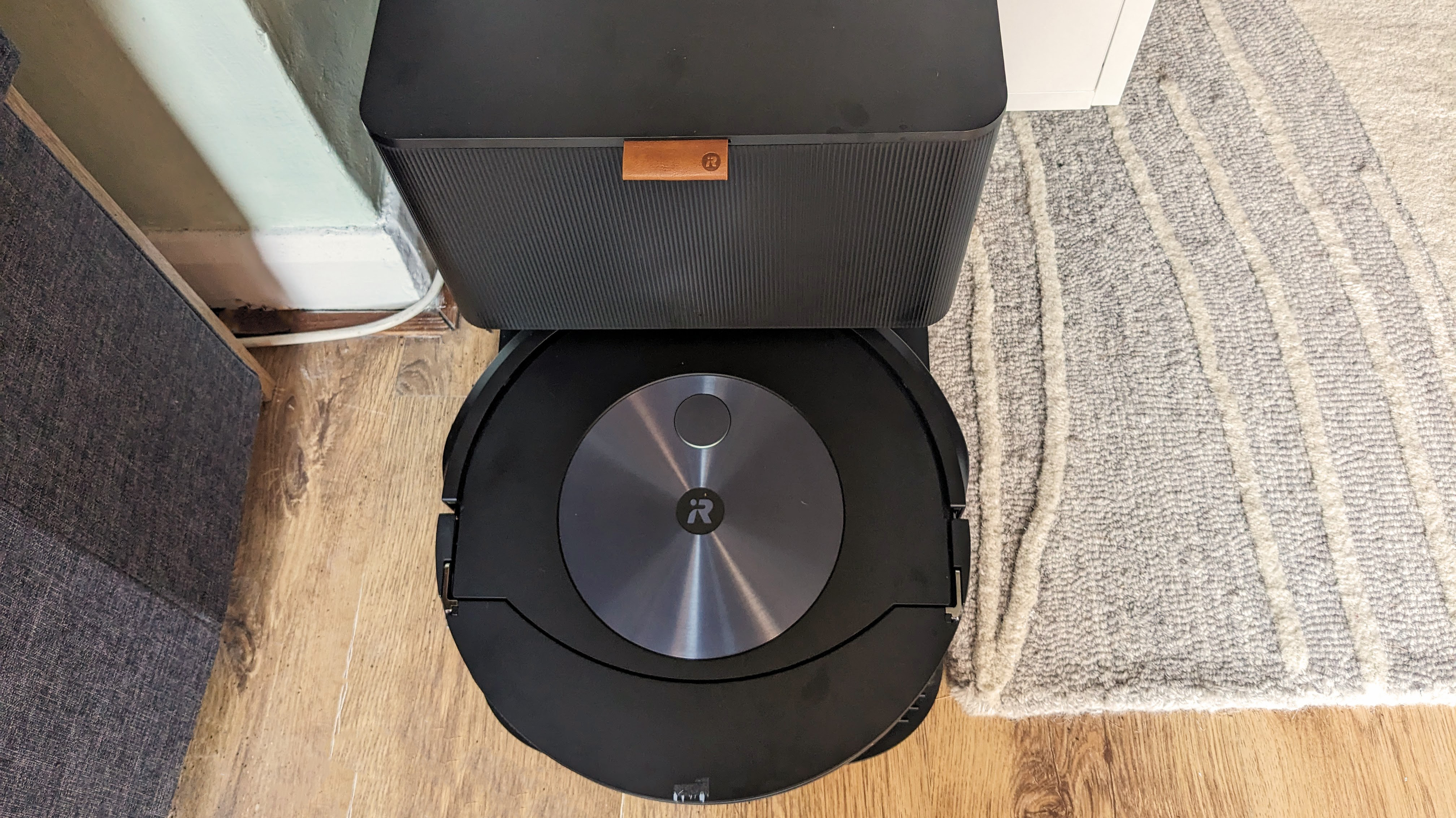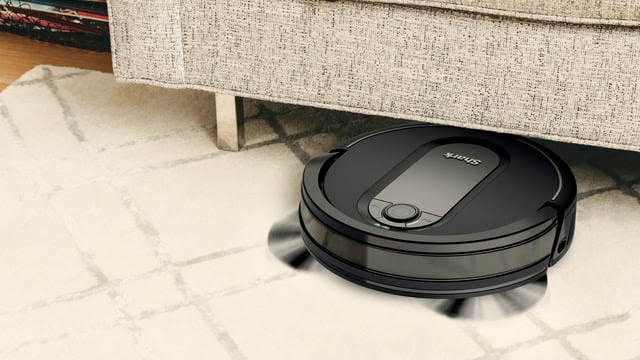Shark vs Roomba: which robot vacuum cleaner brand is best?
Two heavyweight brands, but which robot vacuum will make light work of your chores?

The Shark Detect Pro may be small in stature compared to the upright and cordless cleaners with which Shark made their name, but this nifty robot vacuum isn’t to be sniffed at. With the self-emptying feature, it makes for one less job to do around the home and can help you keep on top of the household cleaning. With a sleek design and attractive looks, it can be a stylish addition to any home alongside a cordless or stick vacuum for reaching every nook and cranny.
Pros
- Excellent object detection
- Good battery life
Cons
- Small dust cup
- Can get tangled with hair
- Disappointing app

The Roomba Combo J7+ scored well in our review, with this model receiving praise for tackling hair and dust with ease. A well-known name means they could rest on their laurels when it comes to design, but that isn’t the case with Roomba, who pay attention to detail with their creations rather than just trading on the recognizable branding. The J7+ could be a worthwhile purchase to add to your cleaning regimen.
Pros
- Avoids pet waste
- Excellent anti-hair wrap technology
- Has a mop too
Cons
- Expensive
- Noisy
- Mapping isn’t perfect
If you’re trying to decide between a Shark vs a Roomba robot vacuum, it can be a tricky choice to make. When it comes to robot vacuum cleaners, there are many things to take into account. From battery life to size and style, to whether it self-empties or you need to tackle the dust yourself - choosing one of the best robot vacuums, or the best Roomba vacuums can be a minefield.
Brand names can also have a big influence on our buying decisions: one of the most commonly thought of names when it comes to robot vacuums is Roomba. Many people call robot vacuums Roombas regardless of the brand, but this doesn’t mean you should overlook Shark’s robot editions.
Cleaning expert Nicola Rodriguez says: “In my opinion, they are both totally different despite both being vacuums. Shark has also been a name for many years, whereas Roomba is still a fairly new device for the home.”
How do Roomba and Shark hold up when it comes to battery life, suction performance, size, self-cleaning, and style? We’ve done the hard work of comparing for you.
When it comes to making decisions, you need to weigh up which is most important for you. Do you want a whisper-quiet robot vacuum that can run at night or an ultra-powerful model that can cope with mud and dirt from several kids, plus a very fluffy pet? The different models also have varying battery lives as well as self-cleaning options.
Nicola suggests: “Always bear in mind the battery power, which will be essential if you are solely using it. You may also want to invest in the cleaning stations that you can buy if it doesn’t come with it, and make sure you allocate a designated spot for the robot vacuum to be kept on charge in your home that is easy for it to move around and get back to.”
Nicola Rodriguez, The Essex House Dolly, started her career in 2002 in interior design and created The Essex House Dolly in 2018. She has the expertise to deep clean your home but also has tricks and tips for organizing, decluttering, and making your home look like a Showhome, and her motto is “A Tidy house is a Tidy Mind.”

Shark vs Roomba robot vacuums: Features & Performance
Capacity
Sign up to receive the latest news, reviews, buying guides and deals direct to your inbox
Dust capacity is a key thing to consider when deciding between a Shark or a Roomba, as it can make a big difference to how often you have to run or clean it. If you live alone in a one-bed apartment, a smaller capacity is less of an issue than if you have a four-bed house with a family. Roomba has more models available than Shark: at the time of writing, there are 15 different types to choose from, with capacity varying from 0.4L to 0.75L on the vacuum itself and up to 42L in the docking station. Shark only has six models to choose from, with an average dust cup capacity of 0.22L. The Combo J7+ has a 0.4L capacity while the dock holds 42L, versus the Shark Detect Pro with 0.22L and 1.3L base capacity.
The Roomba Combo J7+ (at iRobot and Amazon) also has a mop attachment, and it can sense when there is carpet or a rug and retract the mop setting so as not to soak the carpet. The Shark Detect Pro, as the name would suggest, also detects and avoids objects but does not include the combo mop option.
Some of the other Shark models, including the Shark Matrix Plus and the Shark AI Ultra, come with XL HEPA bases, which they say can hold up to sixty days' worth of dirt and dust, so it could be an improvement if you have a big family, lots of pets, or deal with allergies.
Suction power
Some early robot vacuums garnered complaints that they did next to nothing compared to corded or stick hoovers, requiring multiple passes or a complete go-over with the full-sized vacuum instead. Nowadays, most models boast extra power or suction, with some claiming to have suction that is far superior to their predecessors.
Nicola advises using robot vacuums as part of a team: “One of my clients lives in a bungalow with a lot of floor space and is solid throughout (no carpets). I did suggest a robot vacuum to use daily where she also has five dogs so the Roomba can keep on top of the amount of dog hair. Once a week, I go in and use a corded version to do a thorough hoover as the Roomba obviously cannot do the tops of skirting boards, sofas, etc.”
The Roomba Combo J7+ claims to have 10x the suction power of earlier models versus the Shark Detect Pro, which says it has 50% more suction than the prior Shark RV900S.
A good way to test performance is by seeing how robot vacuums cope with a range of debris, varying from sprinkles to oats, rice, cereal, and so on. Under test conditions, the Roomba j7+ cleaned up sprinkles and cereal well, with only a few stray sprinkle strands being thrown off to one side. The Shark Detect Pro performed better with oats and sprinkles on the carpet as opposed to hard or laminate flooring, where it left a trail behind and only picked up half of them. Our reviewer also found that it didn’t transfer all of the dust into the base, spilling some onto the floor.
The top-of-the-range Shark Matrix Plus 2-in-1 (available at Shark and Amazon) seems to have fixed the latter problem, with a HEPA+ standard sealed base, which fans and reviewers report can trap 99.7% of dust and allergens. This model also comes with CleanEdge detect software, which should prevent remnants from gathering around the skirting boards of your kitchen.

Obstacle detection & pet-friendly features
Robot vacuums can make life easier with pets, cleaning up fluff and dander on the go. However, pets can also prove to be a messy nemesis, as many robot vacuums can’t dodge any accidents left by Tiddles or Fido. The Roomba Combo J7+ features a P.O.O.P. (Pet Owner Official Promise), valid for the first year. They promise that the Roomba will identify and avoid solid pet waste, and if it doesn’t, they’ll replace it for free. It uses PrecisionVision Navigation to travel around your home, avoiding things you don’t want it to bump into. Both vacuums also claim to tackle pet fur and human hair well without being tangled. The Shark uses NeverStuck technology to free itself from tight spots and navigate thick carpets and entryways.
The Roomba j9+, one of the higher-end models, can be set to prioritize the dirtiest rooms first, so if you know your kitchen always needs a deep clean after a dog walk, you can set it to work there first before the rest of the house. Like the j7, it has expert obstacle detection.
The Shark Detect Pro - despite the name - didn’t perform as well when it came to recognizing obstacles. Our reviewer found that it would leave a huge space to avoid a dog toy, but then, on another occasion, would run over their feet without attempting to divert or move. It also got wedged on a quarter-inch high grate, reporting that it was a “cliff.”
Verdict: Roomba wins with the increased capacity, suction, and pet promise.
Shark vs Roomba robot vacuums: Control & mapping
Half of the fun of robot vacuums is watching them map out your house or apartment and work out how to dodge obstacles and furniture. There are varying degrees of success for this, and it can cause frustration when the robot vacuum doesn’t clean up a mess the first time, only to then wander off in the opposite direction to do something else.
The Roomba J7+ and J9+ both have spot cleaning options, where you don’t need to do an entire room or house clean and can instead direct the vacuum to the place you need to. The app also intuitively recognized and labeled correctly which room was which after the first mapping excursion. It did apparently require multiple trips to achieve full accuracy, though.
The Shark app doesn’t fare well with reviews, with people finding it confusing to navigate and lacking in features. It also can’t create multiple maps for multi-level homes, unlike the Roomba app.
The J7+ also shows images it has taken of obstacles, which you can swipe through to confirm whether they are correct or to avoid.
Verdict: Roomba seems to use a more reliable and accurate app and mapping system.
Roomba vs Shark robot vacuums: Care & maintenance
When you’ve dropped a serious amount of cash on a robot vacuum, maintenance is key to keeping it in top condition. Nicola advises: “Regularly maintain by cleaning out filters and the bristle brush on the roller, and you can get a pet version which is fantastic specifically for pet hair.”
Many models of robot vacuum, both Shark and Roomba, make their instruction manuals online. It can be well worth taking the time to download the manual of the model you’re considering and checking out what the required care and maintenance schedule is, as often it will recommend a duration of when the filters and dust cup need cleaning or replacing. Some models allow you to use a cleaning liquid, while others require just water and are left to air dry.
The Roomba Combo J7+ features anti-hair wrap technology, so you shouldn’t find yourself wrangling with tangled locks (either of your own or from pets). The Shark Detect Pro sometimes needs the roller removed to detangle hair and fur.
Verdict: Roomba clinches it for the anti-wrap technology, but apart from that, it’s neck-and-neck as they require filter changes, and both come with self-emptying technology.

Roomba vs Shark robot vacuums: Price
There is a whole array of vacuum robots to choose from, and whether you want an entry-level model or a high-tech wonder will impact the price you pay. Roomba has some serious deals on their website, with the Roomba i5 on offer for $229 and the i5+ self-emptying model for $299.99, reduced from $499.99. At the other end of the scale is the Roomba Combo J9+ for $999.99 - down from $1399.99.
For Shark, the most basic model of the Shark ION Robot Vacuum is available for $199.99, reduced from $279.99 if you’re looking for something cheap and cheerful. The top-of-the-line model, the Shark Matrix Plus 2-in-1 Self Empty Robot Vacuum and Mop, will set you back $699.99, so Shark has more affordable options of the two, especially when considering the Roomba sale prices will (presumably) return back to their normal price as well.
Verdict: Shark has more affordable options, hands down.
Roomba vs Shark robot vacuums: Our verdict
Roomba comes out on top for having a wide array of models, and it is more suited for homes with pets thanks to the Pet Promise and advanced navigation system. It also has larger capacity dust cups and bases, and the app receives higher praise than the Shark.
Shark seems to succeed with corded and stick vacuums, but there is still room for improvement when it comes to the robot vacuums. But if you're looking for more affordable options, Shark's range of robot vacuums is a great alternative.

Jen Thomas, a freelance journalist and Magic Radio presenter, is renowned for her 20 years of expertise in reviewing vacuums for Top Ten Reviews. She loves leopard print, houseplants, and mixing patterns. She trains her rescue dog in her free time and tends to her balcony garden.
